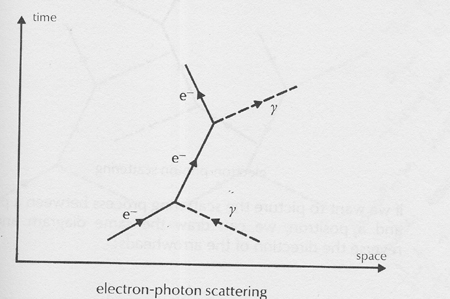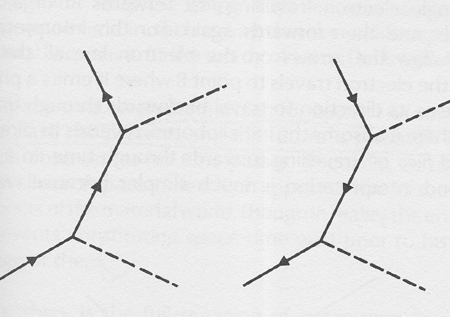
|
Scientific Enlightenment, Div. One
Book 2: Human Enlightenment of the First Axial
2.B.1. A genealogy of the philosophic enlightenment in classical Greece
Interlude to Ch. 7: Parmenidean timeless reality in quantum field theory? (Capra)
ACADEMY | previous section | Table of Content | next section | GALLERY
|
2003, L. C. C.
A word on the singularity of space-time. Fritjof Capra, in his Tao of Physics, finds the "timeless present" in quantum field theory, the relativistic quantum description of particle interactions that have two "characteristic features": "The first is the fact that all interactions involve the creation and destruction of particles, like the absorption and emission of the photon [between two electrons approaching and interacting with one another]; and the second feature is a basic symmetry between particles and anti-particles. For every particle, there exists an antiparticle with equal mass and opposite charge." (Ibid., p. 181) The antiparticle for electron is positron. Diagram 1 illustrates the "collision, or 'scattering', process between an electron and a photon" in the form of world line, i.e. "the path of the particle through space-time":

(Taken from Capra, ibid.)
Here electron, denoted by e-, moves forward in space (from left to right) and time (from bottom to up), and collides with a photon (g as gamma ray); "the photon is absorbed by the electron which continues its path with a different velocity (different inclination of the world line); after a while, the electron emits the photon again and reverses its direction of motion." (Ibid., p. 180-1) "Note that the particles can only move upwards in time, but can move backwards or forwards in space." (Ibid., p. 180) This is denoted by the arrow. "Their world lines can be inclined towards the horizontal to various degrees, but can never become completely horizontal, since this would mean that a particle travels from one place to the other in no time at all." (Ibid.)
In the next, "the arrowhead on a world line is no longer used to indicate the direction of motion of the particle (which is unnecessary, anyway, since all particles move forwards in time...). Instead, the arrowhead is used to distinguish between particles and anti-particles; if it points upwards, it indicates a particle (e.g. an electron), if it points downwards an antiparticle (e.g. a positron). The photon, being its own antiparticle, is represented by a world line without any arrowhead." (as the dash-line; ibid., p. 181-2) All labels and space and time axes are left out. The left diagram below then illustrates the electron-photon scattering already depicted above; the right, the scattering process between a photon and a positron, and it is the same diagram with only the reversal of the direction of the arrowheads:

electron-photon scattering (left) and positron-photon scattering (right)
(Taken from Capra, ibid., p. 183)
Now "the mathematical formalism of field theory suggests that [the world lines of the positron-photon scattering on the right] can be interpreted in two ways; either as positrons moving forward in time, or as electrons moving backwards in time!" (Ibid., p. 183; this is why antiparticles can be conceived of as particles moving backward in time.) "Our two diagrams can thus be seen as picturing the same process [electron-photon scattering] evolving in different direction in time... The relativistic theory of particle interactions shows thus a complete symmetry with regard to the direction of time." (Ibid.)
"To see how this surprising feature of the world of subatomic particles affects our views of space and time, consider the process shown in the diagram below... an electron (represented by a solid line) and a photon (represented by a dashed line) approach each other; the photon creates an electron-positron pair at point A, the electron flying off to the right, the positron to the left; the positron then collides with the initial electron at point B and they annihilate each other, creating a photon in the process which flies off to the left. Alternatively, we may also interpret the process as the interaction of the two photons with a single electron travelling first forwards in time, then backwards, and then forwards again. For this interpretation, we just follow the arrows on the electron line all the way through; the electron travels to point B where it emits a photon and reverses its direction to travel backwards through time to point A; there it absorbs the initial photon, reverses its direction again and flies off travelling forwards through time. In a way, the second interpretation is much simpler because we just follow the world line of one particle. On the other hand, we notice immediately that in doing so we run into serious difficulties of language. The electron travels 'first' to point B, and 'then' to A; yet the absorption of the photon at A happens before the emission of the other photon at B. The best way to avoid these difficulties is to see space-time diagrams like the one [below] not as chronological records of the paths of particles through time, but rather as four-dimensional patterns in space-time representing a network of interrelated events which does not have any difinite direction of time attached to it." (P. 184-5) Capra cites Louis De Broglie: "In space-time, everything which for each of us constitutes the past, the present, and the future is given en bloc... Each observer, as his time passes, discovers, so to speak, new slices of space-time which appear to him as successive aspects of the material world, though in reality the ensemble of events constituting space-time exist prior to his knowledge of them" (Ibid.)

scattering process involving photons, electrons, and a positron
(Taken from Capra, ibid., p. 184)
Thus "to get the right feeling for the relativistic world of particles, we must 'forget the lapse of time'". (Ibid.) This transcendence of time Capra finds in many Eastern mysticism, e.g. the Zen master Dogen: "It is believed by most that time passes; in actual fact, it stays where it is. This idea of passing may be called time, but it is an incorrect idea, for since one sees it only as passing, one cannot understand that it stays just where it is." (Ibid., p. 186) Or Swami Vivekananda: "Time, space, and causation are like the glass through which the Absolute is seen... In the Absolute there is neither time, space, nor causation." (Ibid., p. 187) Or D. T. Suzuki: "In this spiritual world there are no time divisions such as the past, present, and future; for they have contracted themselves into a single moment of the present where life quivers in its true sense..." (Ibid., p. 179) All these in fact are equivalent expressions of the experience of the transcendent reality behind the everyday reality articulated by Parmenides in his poem: that Singularity of no-space and no-time, that which never "was nor will be but Is all of itself, one, and holding together." What is revealed by the relativistic quantum field theory is then that existence in time, our flowing in the temporal flux, is simply an illusion. The Parmenidean insight is therefore correct, that not only existence in space of individual objects but their existence in time is all just an illusion. There is nothing but pure Being (eon; "Is"; which itself should pass into Nothingness if Parmenides continues with his insight). And this insight into the transcendent reality is arrived at, as we have amply demonstrated, through the memory of the law of Conservation.
Even the symmetry with respect to the direction of time as shown by quantum field theory may express the principle of Conservation in a underlying way: that there is really nothing and can be nothing, so that when something happens, another same happens backward in time to reverse (cancel out) the first something. In this way the real timelessness of reality is actually a reflection of its nothingness -- conservedness, and one can arrive at this timelessness either through Logos exerted on the memory of the first law of thermodynamics (philosophy) or through empirical experimentation (physics).
We thus salute Fritjof Capra for noticing the coincidence between modern physics and ancient mysticism of the East, but we however must correct him for not extending the same coincidence to the philosophy of Hellas and supplement his thinking by suppying the reason for this coincidence, i.e. the intuition of the first law of thermodynamics on the part of the ancient mystics.



